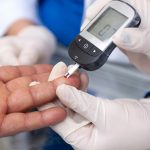 One of the complications associated with diabetes is eye disease. Diabetes can wreak havoc on your vision and eye health, in some cases leading to vision loss. If you have diabetes, it’s important that you keep your condition well managed. If you don’t, you should take the necessary preventative measures to reduce your risk and protect your vision along with overall health.
One of the complications associated with diabetes is eye disease. Diabetes can wreak havoc on your vision and eye health, in some cases leading to vision loss. If you have diabetes, it’s important that you keep your condition well managed. If you don’t, you should take the necessary preventative measures to reduce your risk and protect your vision along with overall health.
Regardless of the type, diabetics have a 25 percent higher risk of vision loss, compared to the general population without diabetes. In diabetes, your body cannot store sugar properly. This fluctuation in blood sugar levels can damage your blood vessels, especially those that supply blood to your eyes. As a result, diabetes means an increased risk for eye complications, including cataracts, glaucoma, and diabetic retinopathy.
Diabetes-related eye diseases
Advertisement
Diabetic retinopathy: High blood sugar levels can damage blood vessels. Too much sugar can also cause blockages to the blood vessels in the retina, obstructing the flow of oxygenated blood. The new blood vessels that are being produced do not develop properly, so they leak.
There are two types of diabetic retinopathy: early diabetic retinopathy and advanced diabetic retinopathy.
Early diabetic retinopathy: In this form of diabetic retinopathy, new blood vessels are not produced. The walls of the blood vessels going to the retina become weak and tiny bulges begin to protrude. This can cause blood and fluid to leak into the retina. Large blood vessels can also assume an irregular diameter, and more blood vessels become blocked.
Nerve fibers in the retina start swelling, and even the central part of the retina may swell. At this stage, treatment is definitely required.
Advanced diabetic retinopathy: Damaged blood vessels start closing off, causing abnormal blood vessels to grow and fluid to leak.
Scar tissue causes the retina to detach from the eye. The new blood vessels block the flow of normal blood, creating pressure behind the eye that leads to nerve damage and potentially can result in glaucoma.
Diabetic macular edema: Diabetic retinopathy is caused by long-term high levels of blood sugar weakening the blood vessels in the eyes. When fluid leaks from these blood vessels, this is referred to as diabetic macular edema. This causes the retina to swell, which hinders the functioning ability of the macula, the part of the eye responsible for sharp vision.
Diabetic macular edema often does not present itself with any symptoms. Patients may notice that images may appear blurry or wavy and colors may look “washed out.”
To diagnose diabetic macular edema, your doctor will conduct a visual exam, including the dilation of the eyes, and a visual acuity test. Other important factors to consider include a family history of diabetic macular edema, high blood sugar levels, high blood pressure or cholesterol, and medications for other conditions.
Cataracts: A research study published in Optometry and Vision Science suggests that age-related cataracts are associated with type 2 diabetes. As part of the study, the researchers collected data from nearly 6,400 patients of the optometry clinic at the University of Waterloo in 2007-2008. Among them, 452 patients had type 2 diabetes, of which 56 percent were taking statins. Among the remaining 9,548 non-diabetic patients, only 16 percent were taking statins. The researchers noted that there was an increased rate of age-related cataracts in both the diabetic patients and the participants taking statins.
Blurry vision: High blood pressure causes the lens to swell, which results in blurry vision. Properly managing your blood sugar levels will correct blurry vision brought on by uncontrolled diabetes.
Glaucoma: This condition can be quite serious and even result in blindness. The older you become, the more prone you are to developing glaucoma. Glaucoma patients typically range between 45 and 64 years of age.
Advertisement
Glaucoma can strike without warning and without symptoms. There is no cure for glaucoma, so it’s important to take the necessary steps to prevent it. This can be done through nutrition and diet, which can deter the onset of this eye condition.
Tips to keep your eyes healthy with diabetes
 Although diabetic eye disease cannot always be prevented, there are still measures you can take to help lower your risk. Diabetic eye disease prevention involves:
Although diabetic eye disease cannot always be prevented, there are still measures you can take to help lower your risk. Diabetic eye disease prevention involves:
- Managing your diabetes – through diet, exercise, and other lifestyle changes
- Monitoring blood sugar levels
- Having a doctor check your hemoglobin levels
- Keeping cholesterol and blood pressure under control
- Quitting smoking
- Paying attention to changes in vision
Diabetes does not have to result in vision loss. With proper management, you can give your eyes a better chance against diabetic eye disease.
